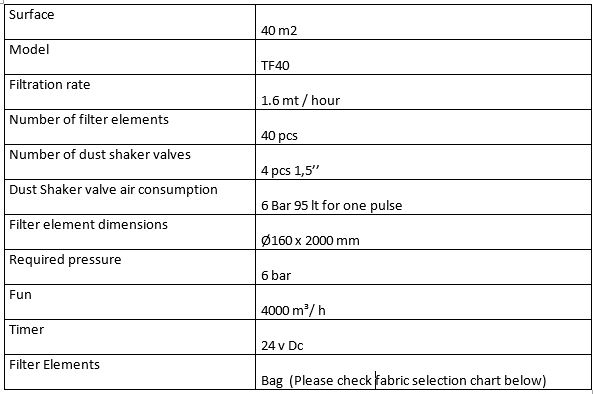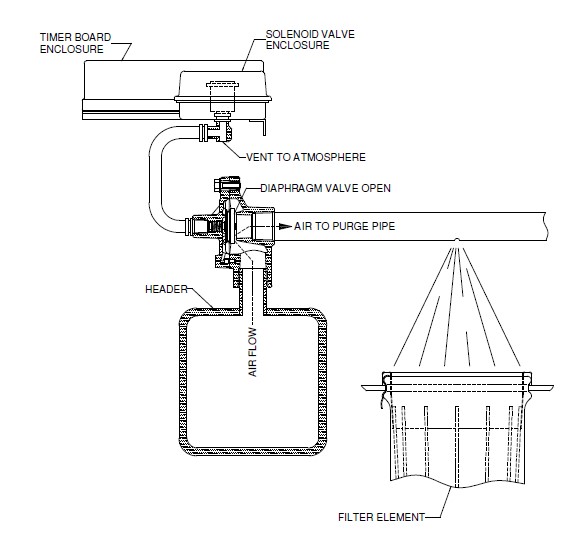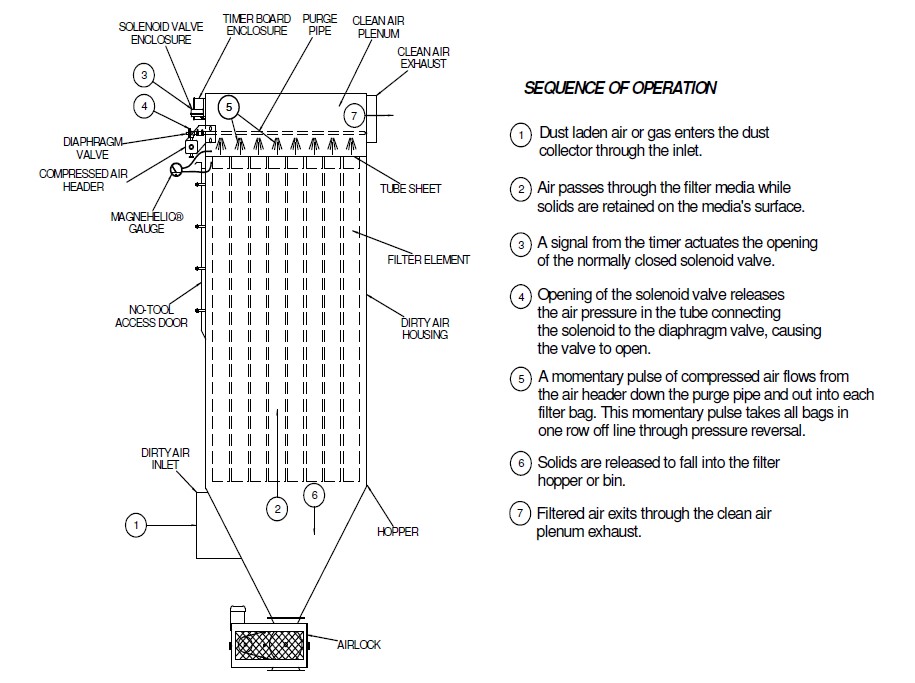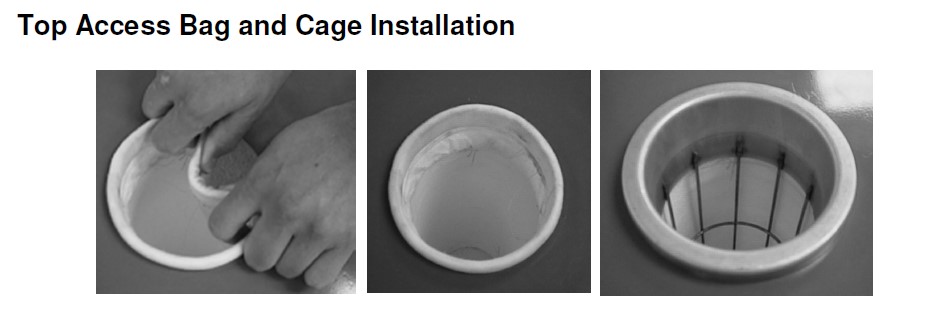Jet Pulse filter bags is manufactured from various materials, which provide different beneficial characteristics. Below is a Fabric Selection chart, which summarizes some of the properties of common fabric materials.
Polypropylene dust suction filter bags
This synthetic is available in both continuous filament and staple fiber form and is produced as either a felt or woven material. Its major limitation is its low maximum continuous operating temperature of 88°C. Oxidizing agents, copper, and related salts damage polypropylene. Its primary benefit is that it is non-hygroscopic (does not chemically react with water). It exhibits great resistance to static build-up and abrasion, and provides a slick surface for good dust cake release during bag cleaning. Polypropylene is widely used in the food, detergent, chemical processing, pharmaceutical, and tobacco industries.
Acrylic dust suction filter bags
These synthetic fibers offer good hydrolytic resistance over a limited temperature range, 127°C) continuous, 135°C surge. Acrylic fibers are used in the manufacture of ferrous and nonferrous metals, carbon black, cement, lime, fertilizers, and following spray-dryers in coal-fired burners. They are also used extensively in wet-filtration applications.
Polyester dust suction filter bags
Today, polyesters are among the most widely used fabrics for general applications below 135°C, their maximum continuous use temperature. Their maximum surge temperature is about 149°C. Polyester fibers are produced in both filament and staple form and are available in both woven and felted fabrics. The primary damaging agents are water (hydrolysis) and concentrated sulfuric, nitric, and carbolic acids. They have good resistance to weak alkalies and fair resistance to strong alkalies at low temperatures. They have good resistance to most oxidizing agents and excellent resistance to most organic solvents.
Ryton dust suction filter bags
This is a relatively new synthetic fiber with a moderate temperature range, 190°C continuous, 232°C surge. It will hydrolyze, but only at temperatures above 190°C . It has excellent resistance to both acids and alkalies, which makes it very useful in combustion-control applications. Its early applications have been on industrial coal-fired boilers, waste-to-energy incineration (with and without spray dryers), titanium dioxide, and installations where Nomex does not perform well due to chemical or hydrolytic attack.
Nomex dust suction filter bags
This is a commonly used fiber for applications in the 135-204°C range. It is produced in both filament and staple fiber form and is available as both woven and felted fabrics. It has excellent thermal stability, shrinking less than 1% at 177°C . The fiber is flame resistant, but when impregnated with combustible dusts, will support combustion that will melt and destroy the fabric. Nomex will begin to hydrolyze at 190°C when the relative humidity is 10% or greater. Hydrolysis changes the normal white or gray fabric to a red-brown color. The presence of acids will catalyze the hydrolysis process. Unacceptably short bag life will result where sulfur oxides (SOx) and moisture are present and frequent dew point excursions occur, such as in coal-fired boilers. Some acid-retardant finishes have been developed for Nomex, but have been found to improve bag life by no more than 50%, leaving most bag life cycles unacceptably short.
Teflon (PTFE) dust suction filter bags
Teflon® is unique among synthetics in its ability to resist chemical attack across the entire pH range throughout its operating temperature range of 232°C continuous, to 260°C surge. This fluorocarbon fiber is non-adhesive, has zero moisture absorption, and is unaffected by mildew or ultraviolet light. The primary shortcomings of Teflon® are its high cost and relatively poor abrasion resistance. However, the higher cost can often be justified through longer bag life in extremely corrosive atmospheres. Felted Teflon® is also produced in combination with staple glass fibers and marketed by DuPont as Tefaire®. This combination produces some improved filtration and flow characteristics. Applications of Teflon® include coal-fired boilers, waste-to-energy incinerators, carbon black, titanium dioxide, primary and secondary smelting operations, and chemical processing.
Fiberglass dust suction filter bags
Most fiberglass fabrics are woven from minute 0.0038 mm filaments. Many variations of yarn construction, fabric weaves, and fabric finishes are available. It is also produced in a felted form. Fiberglass has the highest operating temperature range available in conventional fabrics: 260°C continuous, 288°C surge. Above 260°C, the fiberglass itself is not directly damaged, but the finish which provides yarn-to-yarn lubrication begins to vaporize, resulting in accelerated mechanical wear of the glass fibers. Fiberglass is noncombustible, has zero moisture absorption (cannot hydrolyze), has excellent dimensional stability, and has reasonably good strength characteristics. Woven glass fabrics have high tensile strength characteristics but relatively low flex strength, especially in the fill (circumference) direction of the bag, and low abrasion resistance. Care must be taken to minimize flexing and rubbing. Fiberglass fabrics have relatively good resistance to acids, but impurities in the glass fibers are attacked by hydrofluoric, concentrated sulfuric, and hot phosphoric acids. They also have poor resistance to hot solutions of weak alkalies, acid anhydrides, and metallic oxides. For these reasons, glass fabrics should not be operated below the acid dew point. Fiberglass fabrics are used extensively with coal-fired boilers and high temperature metals applications.
P-84 dust suction filter bags
P-84 is an aromatic polymer fiber produced in felt form only. The unique shape of the fiber produces improved capture efficiency characteristics. This fabric is specified at 260 °C . Composites are available that take advantage of the superior filtration characteristics of P-84 while reducing its cost. Any of the previous felted materials can be combined with P-84 to produce a fabric composite that exhibits the characteristics of both materials.
An important factor for the function and life of the fabric filter is an efficient heat-insulation.To avoid condensation with consequent corrosion and reduced lifetime as well as to avoid uncontrolled heat expansion and deformation, the total surface of the precipitator is insulated are fully with mineral wool from 100 to 200 mm thick.
Teknofilter has helped reduce the environmental impact from industrial production and create safe and clean working environments.
If you need a best solution for high-efficiency air filtration in your all powder operations? TeknoFilter provide superior results 24/7. Just Call…




